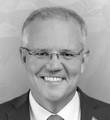Prime Minister
PRIME MINISTER: Australians one, Australians all.
We meet today on the ancient land of the Ngunnawal people, one of the many First Nations people who have cared for this country since time immemorial. I pay my respects to their elders past, present and emerging.
I honour also all the servicemen and women who are here with us today and their veterans and I thank them for their service to our country.
We are gathered in what I like to refer to, our nation's most sacred place.
A monument to all who have served, a shrine to those who were lost, and a solemn landmark for those of us who serve the Australian people in Parliament.
The vista of those who visit Canberra always points to Parliament House, a shining reminder of our liberty and freedom.
But our vista, as parliamentarians, points to this sacred place, an ever present reminder of how our liberties and our freedoms were won and paid for, especially by those whose names line these walls.
Flanking the entrance that we walk through today are those two stone lions. They are proud symbols of Australia's war history and a gift from the Mayor of the people of Ypres in Belgium. For decades, these lions stood at Menin Gate in Ypres.
During the First World War, Australian allied troops in their thousands marched through this gate on their way to the front. For many, it was their point of no return. The final mark of civilisation before the mud and the mayhem of Passchendaele.
One of those who would walk through the Menin Gate was 45 year old Second Lieutenant Bartholomew James Stubbs. He enlisted for service in early 1916 and was described by a Duntroon classmate as a brave, capable and conscientious officer. But he wasn't only serving his country on the battlefield. While he was, while he was fighting on the Western Front, he was also serving as the Labor member for Subiaco in the Western Australian Legislative Assembly.
A soldier legislator, while he was in service, his constituents offered him a unique honour. On the 12th of September 1917, Second Lieutenant Stubbs was re-elected unopposed, appropriately, for the seat of Subiaco.
But just two weeks later, he was shot and killed by a sniper during the battle of Polygon Wood, you will hear more about that battle later. The then Western Australian Premier said of Stubbs, he heard a call that was greater than the call of party.
He certainly did.
He wasn't our only soldier legislator either. Others heard a call greater than the party also, Lieutenant Colonel George Braund, the son of a merchant was from the conservative side of politics, the Liberal Reform member for Armidale in New South Wales Parliament. He was from the bush and he was passionate about cutting taxes, from that same Parliament Sergeant Ted Larkin, the son of a coal miner and the Labor member for Willoughby, also signed up. Larkin was from the city and a proud socialist.
These men came from very different backgrounds and more different - very different political stripes, and they fiercely contended for their beliefs.
Yet somewhere between Sydney Harbour and Albany and Egypt, and then Gallipoli they discovered that what they had in common mattered much more.
Like Second Lieutenant Stubbs they too made the ultimate sacrifice, falling at Gallipoli, two of our original Anzacs.
The note, The Sun newspaper wrote of them, they were elected and stood on the threshold of public careers, the limits or ends of which it was impossible to forsee. There was no place in the public life of Australia that was not open to either of them.
Like all who serve forsaking thresholds without limits for the country they love, it is right that we visit this memorial at the start of our sittings to hear that voice of our country, to be reminded of our duty and our sacrifice, and the threshold's forsaken for us, and to be reminded in the words of a modern soldier turned legislator of our responsibility to uphold the men and women who run to the sound of guns. And who, through their physical and moral courage, protect us all from harm.
Colleagues, and especially veterans, and friends, years after the entrance way at Menin was destroyed a memorial gate was built. That gate bears the names of 50,000 allied soldiers who were killed in the vicinity of Ypres and have no known grave. Amongst them, are 6,178 Australians, including Second Lieutenant Stubbs.
The memorial was inaugurated in July 1927 by Field Marshal Lord Plummer, who comforted the relatives of the missing soldiers with the words: he is not missing. He is here.
As we gather today at the Australian War Memorial we can say the same. They are here.
The 102,000 men and women whose names are on these walls.
They are here with us, their names and their memory. Part of the soul of our nation in this most sacred of places.
Their memory carries on from generation to generation.
So later, as the bugle rings out and we quietly look down Anzac Parade towards our home of democracy. Let us recommit ourselves to let us live up to the example that they have set before us.
Lest we forget.

